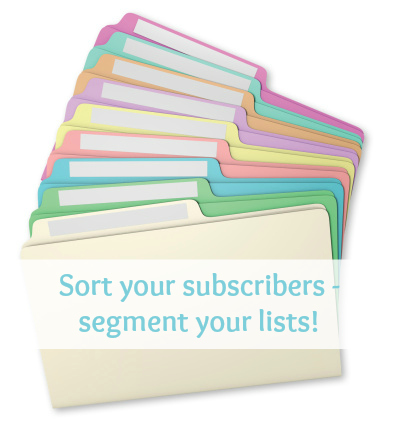 If you have more than one customer, you have more than one type of customer. Although all of your customers may have something (or several things) in common, no two are the same.
If you have more than one customer, you have more than one type of customer. Although all of your customers may have something (or several things) in common, no two are the same.
If they’re not all the same, why should the email messages they receive be the same?
That’s right. The emails your subscribers receive should be just as unique as they are. Sure, it’s not realistic to think you can send a personalized email to each of your subscribers, but you can make them feel like it was sent only to them.
How?
List segmentation.
By using data you collect from your subscribers and their activities, you can personalize the emails so that they’re more relevant to the recipients.
There are countless ways to segment your email marketing, and we’ll get into that in another post in a week or so. But for now, let’s go into why you should segment your email lists in the first place.
3 Reasons to Use Email Segmentation
1. It allows campaigns to be more focused
Your email campaigns need to be as relevant and interesting to your subscribers as possible, or they’ll likely unsubscribe. But it’s hard to choose a message that will be relevant to every single subscriber. They all subscribed to your messaging for different reasons, and want different things.
If you try to please everyone at the same time, you’ll likely end up with long emails with lots of general info about different things. While this may solve the hypothetical problem of a subscriber not seeing anything that interests them, it creates a second problem: focus.
Segmented campaigns can be more focused than ones sent to an entire list. You know the recipients have that one thing in common (for example, zip code), and then that becomes the focus of your email. Send one of these focused emails to each segment, instead of one email with all of that information to everyone.
2. Your subscribers will engage more with personalized, relevant emails
Study after study has shown that using list segmentation improves the results of your email marketing efforts. If subscribers are more interested in the email, they’ll be more likely to open it, click on links, share the information, etc. and less likely to unsubscribe or report you for spam.
MailChimp found that across all segmented campaigns, segmented emails had a 14% higher open rate and 15% more clicks on links in the emails. Imagine how much better your email’s calls-to-action will perform in segmented campaigns where you know the recipients are going to be interested in your offer.
3. Subscribers are less likely to report or unsubscribe
Try to think of a few reasons someone might report a company for spamming, or unsubscribe from their email list. I’ll bet the first reason you came up with is “sending unwanted emails.” If you keep emailing someone stuff that other customers like but they don’t, they’ll want to stop getting them.
However, if you’re consistently sending them stuff they want to read, they’ll just want you to continue doing that. HubSpot wrote about a Lyris report that stated segmented, targeted emails had 28% lower unsubscribe/opt-out rates and 15% less spam complaints. Try and tell me you wouldn’t want that boost in sender reputation!
In the coming weeks, we’ll go more into list segmentation, like how to actually collect the data you segment by, and some good ways to segment your lists. But for now, we’ll leave you to wonder why you haven’t started segmenting already!